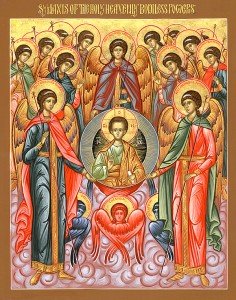During this past week, November 8th, our Church celebrated the feast of the Synaxis of St. Michael the Archangel. This feast also includes the rest of the Angelic Powers. It is perhaps in the Divine Liturgy that the sense of the presence of the angels is most keenly felt. As the holy gifts are carried through the church from the Prothesis (Table of Preparation) to the Holy Table, we sing the Cherubic Hymn. And when we come to sing the thrice-holy hymn in the eucharistic prayer, we recall the thousands of Archangels and tens of thousands of the angels, the Cherubim and the Seraphim. So as we come into the presence of God, pre-eminently in worship, we are made aware of the presence of the angelic hosts that stand before God. It is as if the angels are the sparks that fly off as God and His creation encounter each other.
 The feast in honor of St. Michael and all the other angelic hosts was established in the fourth century. This feast is called a synaxis (assembly) because on this day the Church celebrates the assembly of all the bodiless powers together with St. Michael, Chief of the heavenly hosts and the assembly of the faithful on earth who gather together to pay homage to the heavenly powers.
The feast in honor of St. Michael and all the other angelic hosts was established in the fourth century. This feast is called a synaxis (assembly) because on this day the Church celebrates the assembly of all the bodiless powers together with St. Michael, Chief of the heavenly hosts and the assembly of the faithful on earth who gather together to pay homage to the heavenly powers.
We celebrate the Synaxis in November because formerly, when the year began with the month of March, this month was the ninth month in the year and so it bore a symbolic relationship to the nine choirs of angels. The nine ranks of angels are: Seraphim, Cherubim, Thrones, Dominions, Powers, Authorities, Principalities, Archangels and Angels. Fathers of the East and West showed their approval of angelic cult and testified to its early existence. The earliest known devotion to angels was principally centered on the Archangel Michael, the only individual angel honored in liturgical feasts in the Church before the 9th century. In the East, Michaeline devotion was evidenced by the fourth century in the churches and sanctuaries in and near Constantinople.
The Christian concept of angelic cult is verified only in practices of genuine, divinely revealed, religion and has no equivalent in pagan cults associated with angels. The Old Testament offers some manifestations of angelic cult, but such practices did not constitute the principal object of prophetic teaching; not did people, though conscious of angels, consider their existence relevant. In the New Testament, the Gospels mention angels but do not specifically recommend or reject devotion to them. St. Paul implicitly teaches veneration of angels but such cult is to be given in a manner that does not derogate from Christ, the one and unique mediator. Paul showed displeasure at false or exaggerated cult to angels. Angels are part of the invisible world that we profess exists in God’s creation.
